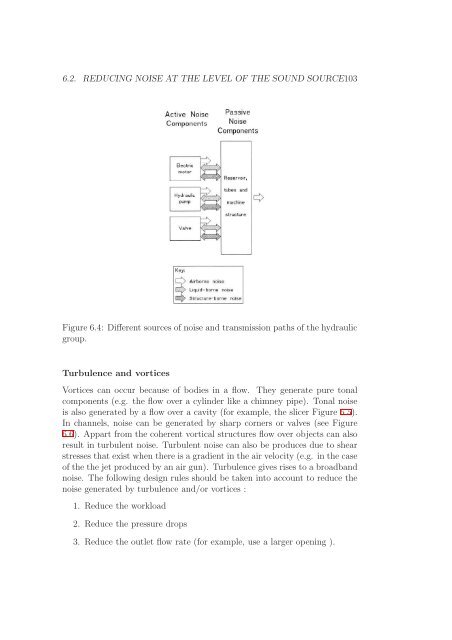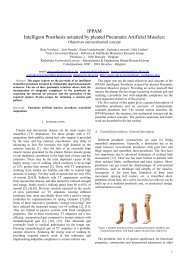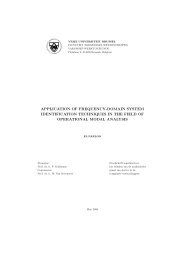- Page 1:
VRIJE UNIVERSITEITBRUSSELAcousticsB
- Page 4 and 5:
iiWhen sound becomes noise, it will
- Page 7 and 8:
ContentsI Introduction to acoustics
- Page 9 and 10:
CONTENTSvii4.3 Measuring the acoust
- Page 11:
Part IIntroduction to acoustics1
- Page 14 and 15:
4 CHAPTER 1. FUNDAMENTAL CONCEPTS O
- Page 16 and 17:
6 CHAPTER 1. FUNDAMENTAL CONCEPTS O
- Page 18 and 19:
8 CHAPTER 1. FUNDAMENTAL CONCEPTS O
- Page 20 and 21:
10 CHAPTER 1. FUNDAMENTAL CONCEPTS
- Page 22 and 23:
12 CHAPTER 1. FUNDAMENTAL CONCEPTS
- Page 24 and 25:
14 CHAPTER 1. FUNDAMENTAL CONCEPTS
- Page 26 and 27:
16 CHAPTER 1. FUNDAMENTAL CONCEPTS
- Page 28 and 29:
18 CHAPTER 1. FUNDAMENTAL CONCEPTS
- Page 30 and 31:
20 CHAPTER 1. FUNDAMENTAL CONCEPTS
- Page 32 and 33:
22 CHAPTER 1. FUNDAMENTAL CONCEPTS
- Page 34 and 35:
24 CHAPTER 2. THE HUMAN HEARING SYS
- Page 36 and 37:
26 CHAPTER 2. THE HUMAN HEARING SYS
- Page 38 and 39:
28 CHAPTER 2. THE HUMAN HEARING SYS
- Page 40 and 41:
30 CHAPTER 2. THE HUMAN HEARING SYS
- Page 42 and 43:
32 CHAPTER 2. THE HUMAN HEARING SYS
- Page 44 and 45:
34 CHAPTER 3. MEASURING SOUNDconver
- Page 46 and 47:
36 CHAPTER 3. MEASURING SOUNDFigure
- Page 48 and 49:
38 CHAPTER 3. MEASURING SOUNDFigure
- Page 50 and 51:
40 CHAPTER 3. MEASURING SOUNDFigure
- Page 52 and 53:
42 CHAPTER 3. MEASURING SOUNDFigure
- Page 54 and 55:
44 CHAPTER 3. MEASURING SOUNDfactor
- Page 56 and 57:
46 CHAPTER 3. MEASURING SOUNDFigure
- Page 58 and 59:
48 CHAPTER 3. MEASURING SOUNDFigure
- Page 60 and 61:
50 CHAPTER 3. MEASURING SOUNDFor ex
- Page 62 and 63: 52 CHAPTER 3. MEASURING SOUNDderiva
- Page 64 and 65: 54 CHAPTER 3. MEASURING SOUNDThe so
- Page 66 and 67: 56 CHAPTER 3. MEASURING SOUND
- Page 69 and 70: Chapter 4Sound AbsorptionAll(constr
- Page 71 and 72: 4.1. ACOUSTIC TRANSMISSION BETWEEN
- Page 73 and 74: 4.1. ACOUSTIC TRANSMISSION BETWEEN
- Page 75 and 76: 4.2. REALIZATION OF ACOUSTIC ABSORP
- Page 77 and 78: 4.2. REALIZATION OF ACOUSTIC ABSORP
- Page 79 and 80: 4.2. REALIZATION OF ACOUSTIC ABSORP
- Page 81 and 82: 4.3. MEASURING THE ACOUSTIC ABSORPT
- Page 83 and 84: 4.3. MEASURING THE ACOUSTIC ABSORPT
- Page 85 and 86: 4.3. MEASURING THE ACOUSTIC ABSORPT
- Page 87 and 88: 4.4. THE DIRECT AND DIFFUSE SOUND F
- Page 89 and 90: 4.4. THE DIRECT AND DIFFUSE SOUND F
- Page 91 and 92: Chapter 5Sound InsulationWhen consi
- Page 93 and 94: 5.1. MEASURING SOUND INSULATION 83F
- Page 95 and 96: 5.1. MEASURING SOUND INSULATION 85F
- Page 97 and 98: 5.2. AIRBORNE SOUND INSULATION OF A
- Page 99 and 100: 5.2. AIRBORNE SOUND INSULATION OF A
- Page 101 and 102: 5.2. AIRBORNE SOUND INSULATION OF A
- Page 103 and 104: 5.2. AIRBORNE SOUND INSULATION OF A
- Page 105 and 106: 5.3. THE ACOUSTICAL BARRIER 95For t
- Page 107 and 108: 5.3. THE ACOUSTICAL BARRIER 97Figur
- Page 109 and 110: Chapter 6Noise control6.1 Origin of
- Page 111: 6.1. ORIGIN OF NOISE 101Figure 6.2:
- Page 115 and 116: 6.2. REDUCING NOISE AT THE LEVEL OF
- Page 117 and 118: 6.2. REDUCING NOISE AT THE LEVEL OF
- Page 119 and 120: 6.2. REDUCING NOISE AT THE LEVEL OF
- Page 121 and 122: 6.3. TACKLING NOISE TRANSMISSION 11
- Page 123 and 124: 6.3. TACKLING NOISE TRANSMISSION 11
- Page 125 and 126: 6.4. RADIATION NOISE 115Figure 6.17
- Page 127 and 128: 6.4. RADIATION NOISE 117Figure 6.20
- Page 129: Part IIINoise directives119
- Page 132 and 133: 122
- Page 134 and 135: 124CHAPTER 7. DIRECTIVE 2000/14/EG:
- Page 136 and 137: 126CHAPTER 7. DIRECTIVE 2000/14/EG:
- Page 138 and 139: 128 CHAPTER 8. NOISE ON THE WORK FL
- Page 140 and 141: 130 CHAPTER 8. NOISE ON THE WORK FL
- Page 142 and 143: 132 CHAPTER 8. NOISE ON THE WORK FL
- Page 144 and 145: 134 CHAPTER 8. NOISE ON THE WORK FL
- Page 146 and 147: 136 CHAPTER 8. NOISE ON THE WORK FL
- Page 148 and 149: 138 CHAPTER 8. NOISE ON THE WORK FL
- Page 150 and 151: 140 CHAPTER 9. COMMUNITY NOISE2. No
- Page 152 and 153: 142 CHAPTER 9. COMMUNITY NOISE
- Page 154 and 155: 144 APPENDIX A. MATERIAL PROPERTIES
- Page 156 and 157: 146 APPENDIX A. MATERIAL PROPERTIES
- Page 158 and 159: 148 APPENDIX A. MATERIAL PROPERTIES
- Page 160 and 161: 150 APPENDIX A. MATERIAL PROPERTIES
- Page 162:
152 BIBLIOGRAPHY[12] Bruel and Kjae
















